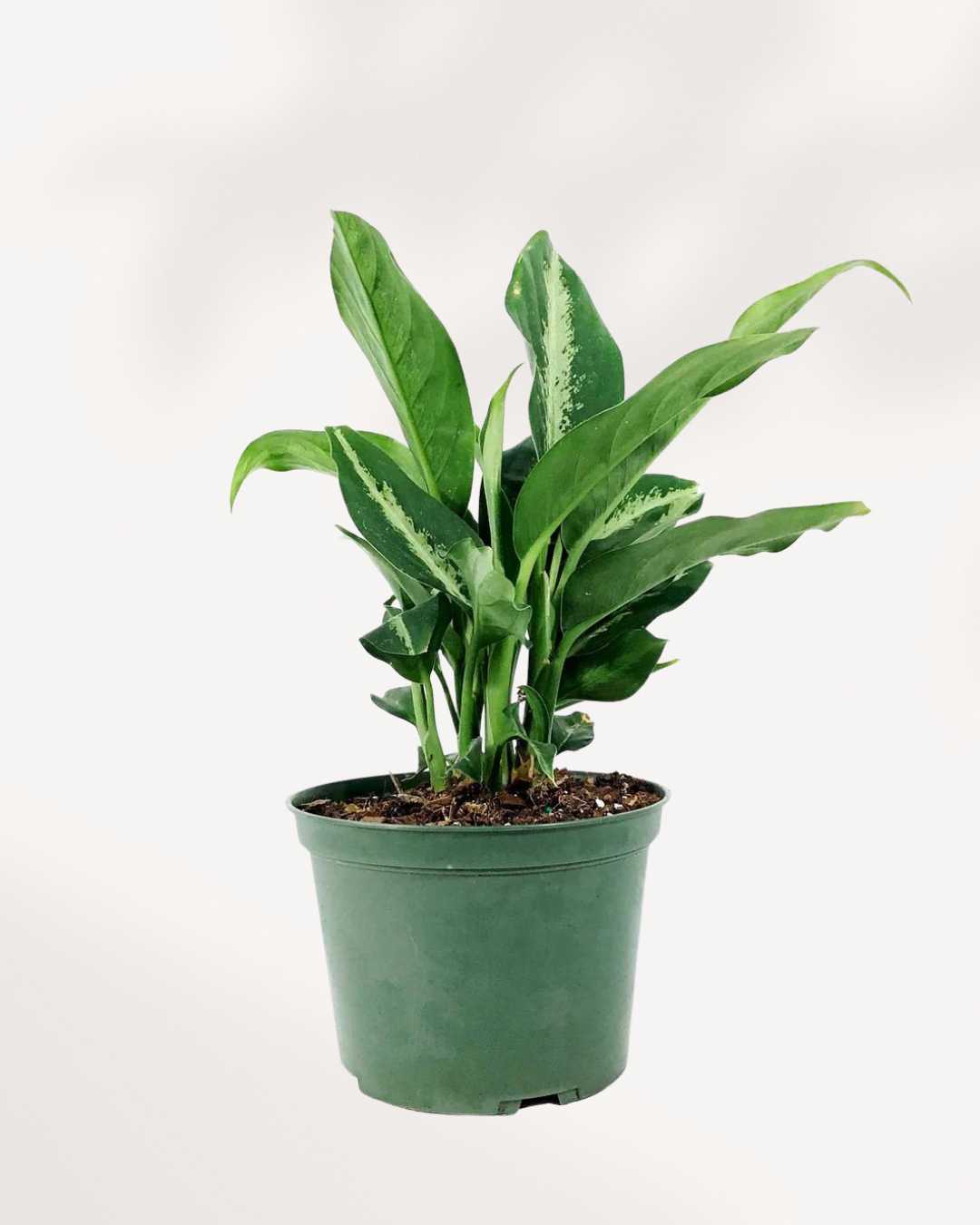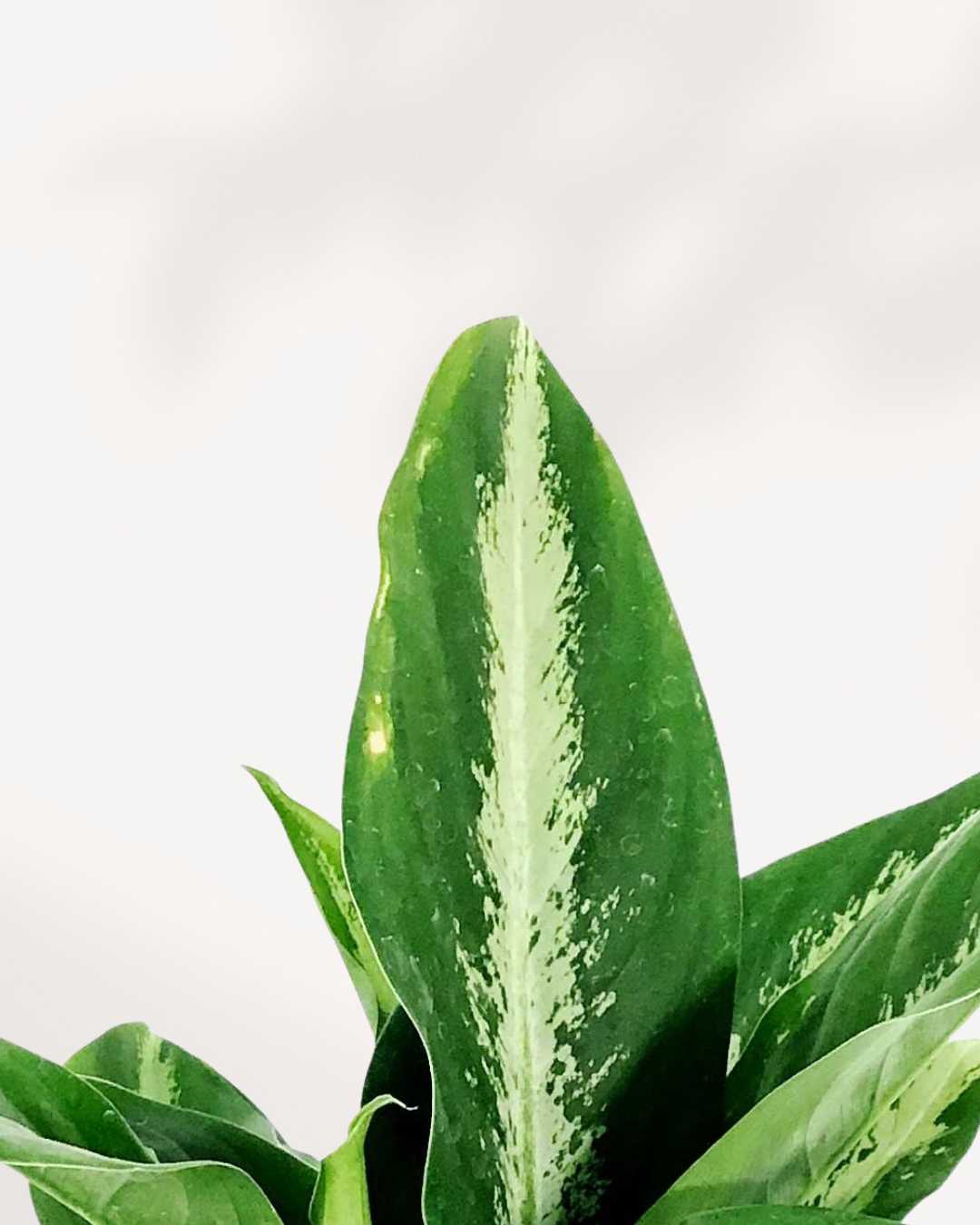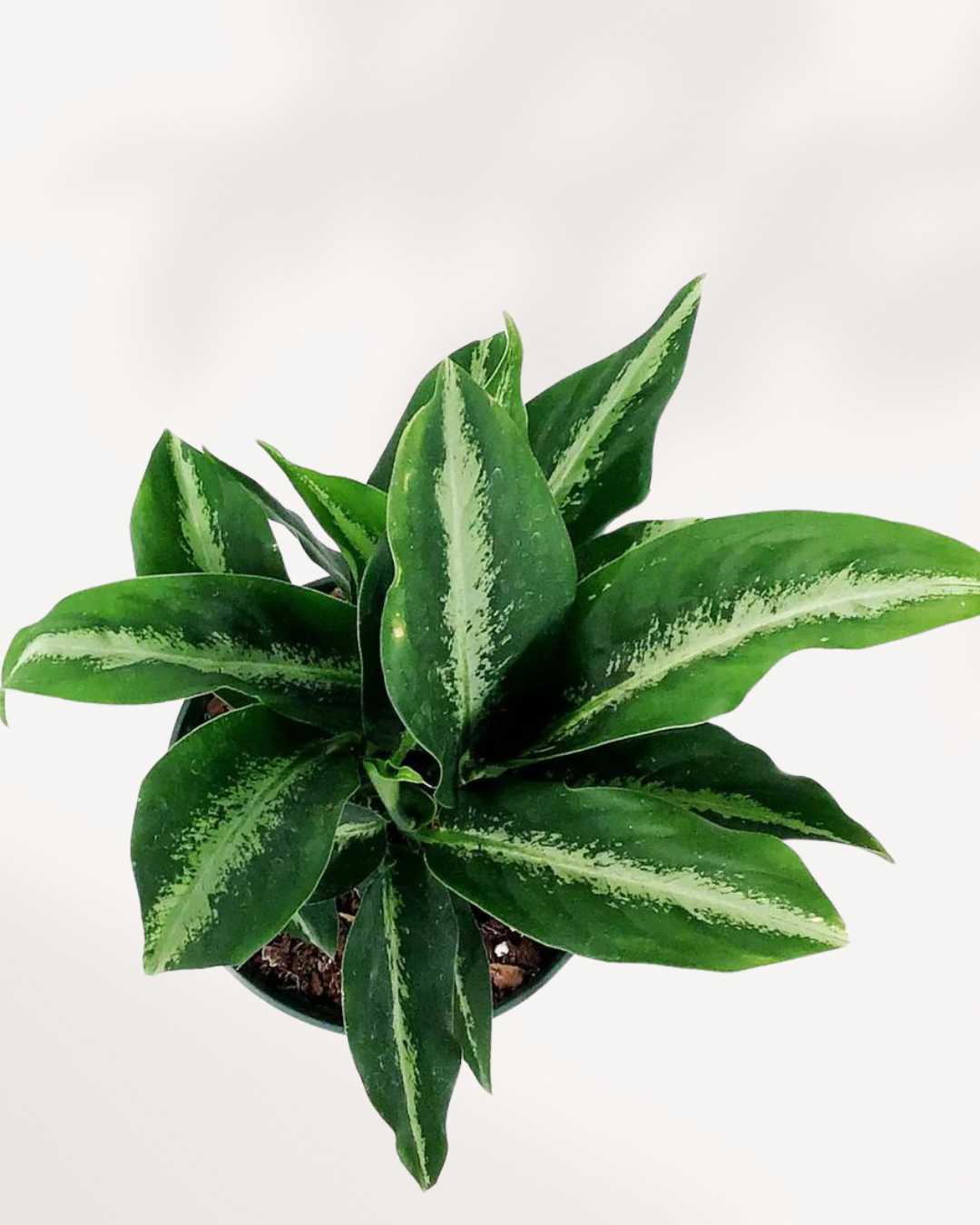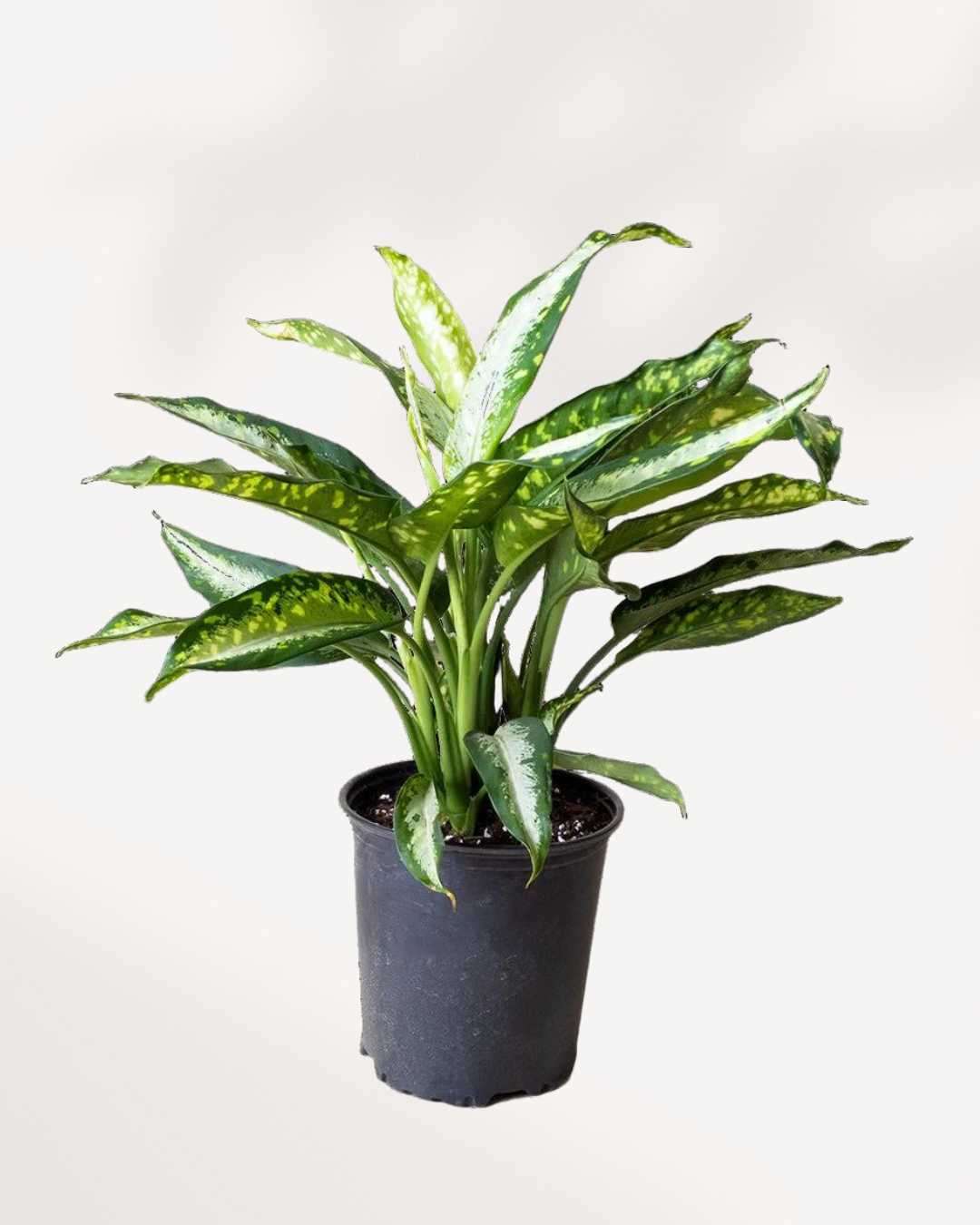Couldn't load pickup availability
Dieffenbachia Panther – Bold Contrast and Tropical Drama
The Dieffenbachia Panther is a striking houseplant with lush dark green leaves boldly splashed with silver-white markings. Known for its dramatic pattern and upright growth, this tropical beauty is a standout piece for any interior space.
Why You'll Love Dieffenbachia Panther
- 🌿 Unique mottled leaves with bold light and dark contrasts
- 🌱 Upright growth makes it an excellent floor plant
- ☀️ Thrives in medium to bright indirect light
- 🪴 Adds a touch of the tropics with minimal care needs
Common Names
- Dieffenbachia Panther
- Dumb Cane Panther
Botanical Classification
- Kingdom: Plantae
- Family: Araceae
- Genus: Dieffenbachia
- Species: Dieffenbachia spp.
Where It Comes From
Native to the tropical regions of Central and South America, Dieffenbachia thrives in humid forest understories. The Panther variety has been cultivated for its unique leaf patterns that bring a bold, decorative flair indoors.
A Tropical Accent with Personality
Dieffenbachia Panther instantly elevates any space with its dramatic foliage. Perfect for living rooms, offices, or entryways, it makes a statement while being surprisingly easy to maintain.
Why It's So Popular
- Striking foliage that commands attention
- Easy to grow indoors with indirect light
- Perfect size for floor displays or corner accents
- Low-maintenance tropical elegance
What Does It Look Like?
Appearance
The Panther features large, broad leaves in deep green, dappled with bold strokes and speckles of creamy silver. The contrast gives it a powerful, eye-catching look.
Growth Habit
This plant grows upright, forming a central stem with new leaves unfurling from the top. Over time, it can reach a medium floor-plant height, making it a natural focal point.
Dealing with Pests
Spider Mites
Wipe leaves regularly and mist to maintain humidity. Treat with neem oil if webs appear.
Mealybugs
Remove with a cotton swab dipped in alcohol and monitor for recurrence.
Aphids
Rinse foliage with water or apply insecticidal soap to prevent infestations.
Frequently Asked Questions
How much light does Dieffenbachia Panther need?
Medium to bright indirect light is ideal. Avoid direct sunlight which can scorch leaves.
How often should I water it?
Water when the top inch of soil feels dry. Keep soil evenly moist but not soggy.
Is it safe for pets?
No, Dieffenbachia is toxic if ingested, so keep it away from cats, dogs, and children.
Does it grow tall?
Yes, Dieffenbachia Panther can grow into a medium-sized floor plant, making it perfect as a decorative indoor feature.
Learn More About Dieffenbachia Plant Care
For tips on watering, lighting, and keeping your Dieffenbachia healthy, visit our Dieffenbachia Plant Care Guide.
Bring Bold Foliage into Your Home
Order your Dieffenbachia Panther today and enjoy its tropical elegance and dramatic leaf patterns.
Shop NowHow to take care of Dieffenbachia Panther
Sun: Indirect
Sun: Indirect
Light: Medium
Light: Medium
Water: When half dry
Water: When half dry
Humidity: Medium
Humidity: Medium
Pet Friendly: Caution
Pet Friendly: Caution
Pro Tip
Pro Tip
Delivery Policy for Plant Condition
Delivery Policy for Plant Condition
"I have only received part of my order. What to do?
No worries if you've only got part of your order! Our plants come from different nurseries and might arrive in separate shipments, typically 1-2 days apart. It's all part of ensuring your green friends reach you in top-notch condition!
If you do not receive the remaining packages within 48 hours contact support at info@mygreenscape.ca
What is the Life Time Support?
Absolutely! Lifetime support means you can count on us whenever you have questions or uncertainties about your plant. Whether you're puzzled by its behavior or just want to ensure it's thriving, we're here for you. Connect with us on Instagram @mygreenscapeto or shoot us an email at support@mygreenscape.ca.
When it comes to our guarantee for plants shipped with standard or express, rest assured that we offer a 30-day happy healthy plant guarantee on all such shipments. This ensures that your plants are covered for 30 days after delivery, giving you peace of mind regarding their condition. If you have any concerns within this period, feel free to reach out to us for assistance.
For further details, please visit our Local Delivery, Store Pickup, Standard Shipping Guide Page.
What to expect
What to expect
Your plant will arrive in a standard nursery pot, typically 0.5" - 1" smaller than the stated size to seamlessly fit into your chosen decorative pot. Washable Paper Planter Bags are available for separate purchase.
Just like nature intended, each plant is unique, showcasing natural variations in size, shape, and characteristics. Our commitment is to deliver a plant that closely resembles the one featured on our website, matching your chosen size, and with the potential to thrive happily in your home.
Frequently Asked Questions
Frequently Asked Questions
Certainly! If you're pondering about ordering plants online, you're not alone. We've compiled the most frequently asked questions. Check out our FAQ section here for quick answers! Happy planting!
Plant & Pot Size Chart
Plant & Pot Size Chart
Choosing the right pot size for your plants can be a daunting task, especially if you're new to gardening. But fear not! Our pot sizes chart can help you find the perfect match for your plants, ensuring they have enough space to grow and thrive. With our guide, you'll be able to confidently choose the right pot size and plant variety for your gardening needs.
Plant Pot Size Guide.

| Extra Small | 7-10 cm | 2.5 - 3 inches |
| Small | 11-12 cm | 3.5 - 4 inches |
| Medium | 14-17 cm | 5 - 6 inches |
| Large | 19-21 cm | 8 - 10 inches |
| Extra Large | 24-27 cm | 12 - 14 inches |
All sizes are specified in product details.
Your Complete Guide to Pot Sizes: What Size Should You Choose?

When selecting a pot for your plant, it's important to find the right size. But with all the different options out there, how do you know which one is best? We're here to help!
MyGreenscape's pot sizes chart is a great resource for finding your perfect fit. Our easy-to-read chart takes out all the guesswork and helps you quickly choose the right size for your plant.
Smaller pots are best for seedlings or small plants just starting out. These tend to be shallow but wide, allowing enough room for the roots of the young plant but not too much where they get overcrowded. Medium-sized pots are ideal when your plant has grown from its infancy and is ready for more space. These are deeper and wider than small pots, so that it can accommodate larger root systems - making sure your plant gets enough nourishment while still giving it breathing room. Large pots are top choice if you have an established plant in need of lots of space - think trees and large shrubs! The spacious depth and width allow plenty of room for deep root systems without struggling for air or light.
No matter what size you choose, MyGreenscape has got you covered, with our pot sizes chart guaranteeing you find the perfect fit every time!
Winter Shipping Protection
Winter Shipping Protection
We take extra care with each package during the colder months. For destinations experiencing cold weather, we provide insulated packaging and heat packs as needed to protect your plants from freezing temperatures. With Winter Shipping Protection, your plants are equipped to arrive safe and sound, even in winter’s chill.
Care Guide
Care Guide
Explore essential care tips. check out our Comprehensive Resource for Indoor Plant Care.




WATERING MADE EASY
Check soil moisture before watering and use a potting mix that drains well. It’s the secret to healthy, happy plants!
Hear From Happy Plant Parents.
Who have brought Mygreenscape plants into their homes.


















